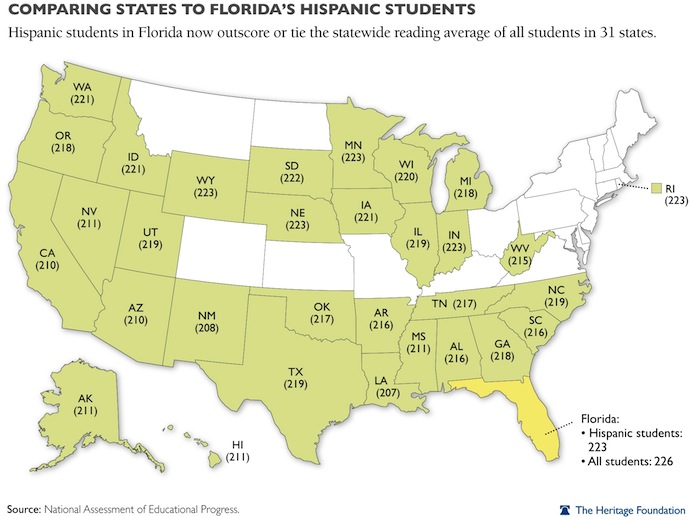Last year, Dan Lips and I demonstrated, in the pages of Education Next, that demography is not K-12 destiny. We cited the remarkable progress of disadvantaged students in Florida based on 1998-2007 NAEP data. NAEP has released the 2009 data, and the news for Florida just keeps getting better.
Education reform in Florida represents a tougher nut to crack than in Massachusetts or New Hampshire. Low-income students make up more than half the K-12 student body in Florida, with a “majority minority” ethnic mix. Florida spends below the national average on per-student funding.
Governor Jeb Bush pushed through a bracing dual strategy of accountability from both the top down (state testing) and bottom up (parental choice) in 1999. Governor Bush’s A+ Plan emphasized standards for schools and transparency for parents. In addition, Florida embraced sensible education reforms such as alternative teacher certification, the curtailment of social promotion for students lacking basic literacy skills and the revamping of literacy instruction. Florida is also the nation’s leader in virtual education.
Florida’s choice strategy also included the creation of the nation’s largest voucher program–the McKay Scholarship Program–for students with disabilities and the “Step Up for Students” tax credit for economically disadvantaged children. Today, more than 820 Florida private schools educate almost 20,000 children with disabilities through McKay. A similar number of low-income parents exercise choice through the Step Up for Students program. Florida also has a vigorous and growing charter school program, with 413 charter schools (and counting) educating over 131,000 students.
So what does Florida have to show for this tough mixture of testing and parental choice? The best source of data to answer this question comes from the federal government. The National Assessment of Education Progress (NAEP) tests representative samples of students in the states on a variety of subjects. The NAEP provides the nation’s most reliable and respected source of K-12 testing data.
Children who do not learn to read in the early grades almost never recover academically, falling further and further behind with each passing grade. Reaching the middle school years, they literally cannot read their textbooks. Such students become academically frustrated and often disruptive. Hopelessly behind, such children begin dropping out of school in large numbers in the 8th grade.
Researcher focus heavily on 4th grade reading scores as a result. In 1998, a stunning 47 percent of Florida 4th graders were on just this dropout track, scoring “below basic” on the 4th grade NAEP reading test. In 2009, 27 percent of Florida’s 4th graders scored below basic on 4th grade reading. The percentage of Florida children failing to master basic literacy dropped by 42.5 percent in the space of a decade- a remarkable achievement.
Best of all, improvements among Hispanic and African American students helped to drive the overall results. Florida’s Hispanic scores have soared in recent years. Florida’s Hispanic students now have the second highest reading scores for Hispanic students in the nation, and African Americans in Florida score 4th highest when compared to their peers in other states.Both groups have a great deal of momentum on their side.
The average NAEP reading score for Hispanic students in Florida (on a test conducted in English mind you) is now higher than the overall average scores (for students from all racial and ethnic groups) of Alabama, Alaska, Arkansas, California, Georgia, Hawaii, Idaho, Illinois, Indiana, Iowa, Louisiana, Michigan, Minnesota, Mississippi, Nebraska, Nevada, New Mexico, North Carolina, Oklahoma, Oregon, Rhode Island, South Carolina, South Dakota, Tennessee, Texas, Utah, Washington, West Virginia, Wisconsin and Wyoming.
Likewise, NAEP reading scores for Florida’s African American students have soared since 1998, from significantly below the national average for African Americans to significantly above. Florida’s African American students have made so much progress in reading that they tied or exceeded the average scores for students from all racial and ethnic groups in 8 states: Alaska, Arizona, California, Hawaii, Louisiana, Mississippi, Nevada and New Mexico.
Florida’s reform record provides hope to a nation struggling to improve education and to close racial achievement gaps. Given the proper incentives, public schools can improve. Disadvantaged children can learn at levels previously thought reserved for the privileged. Demography need not become destiny.
To paraphrase Rob Reiner, when it comes to K-12 reform: I’ll have what Florida is having!
Matthew Ladner is Vice President for Policy Research at the Goldwater Institute



